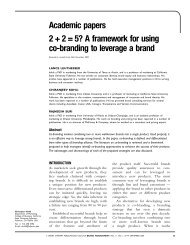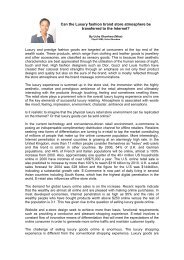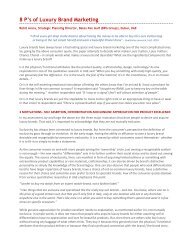Fall of Traditional Brand Management: Making Way ... - Brandchannel
Fall of Traditional Brand Management: Making Way ... - Brandchannel
Fall of Traditional Brand Management: Making Way ... - Brandchannel
You also want an ePaper? Increase the reach of your titles
YUMPU automatically turns print PDFs into web optimized ePapers that Google loves.
<strong>Fall</strong> <strong>of</strong> <strong>Traditional</strong> <strong>Brand</strong> <strong>Management</strong>:<br />
<strong>Making</strong> <strong>Way</strong> for CRM and Business Equity<br />
Dr. M J Xavier<br />
Dean, Academy for management Excellence, Chennai – 600 034, India
<strong>Fall</strong> <strong>of</strong> <strong>Traditional</strong> <strong>Brand</strong> <strong>Management</strong>:<br />
<strong>Making</strong> <strong>Way</strong> for CRM and Business Equity<br />
ABSTRACT<br />
In the first part <strong>of</strong> the article the rise and fall <strong>of</strong> branding and brand management is<br />
discussed in detail. Though branding is an age old concept, it assumed greater importance<br />
during the mass marketing era when the brand owners had no direct contact with the<br />
ultimate consumers and vice versa. <strong>Brand</strong>s became the embodiment <strong>of</strong> product value,<br />
customer relationship and company image. However the downfall started with the<br />
emergence <strong>of</strong> the internet era.<br />
The second part discusses the emergence <strong>of</strong> CRM and provides a new model <strong>of</strong> Business<br />
equity that looks at issues in an integrated manner. Basically the age <strong>of</strong> interactivity has<br />
made it possible for companies to address customers on a one-to-one basis and custom<br />
design products according to individual specifications. Hence the traditional brand<br />
management concept is giving way to a new integrated model <strong>of</strong> Business Equity that<br />
combines brand, customer and value equities.<br />
2
<strong>Fall</strong> <strong>of</strong> <strong>Traditional</strong> <strong>Brand</strong> <strong>Management</strong>:<br />
<strong>Making</strong> <strong>Way</strong> for CRM and Business Equity<br />
INTRODUCTION:<br />
<strong>Brand</strong>ing has dominated the marketing literature for several decades. Though branding is<br />
an age old concept, brand management is believed to have emerged in 1931 when the<br />
president <strong>of</strong> Procter & Gamble decided that each P&G brand should have its own brand<br />
assistants and managers dedicated to the advertising and other marketing activities for the<br />
brand. A separate sales department was responsible for getting products on to retailers’<br />
shelves. The branding strategy required companies to spend heavily on mass media<br />
campaigns and build a brand and the world would beat a path to its doors. Long standing<br />
brands such as Marlboro, Coca-Cola, Xerox, IBM, and Intel are considered to be among<br />
the world’s most valuable assets. This has motivated many companies to base their<br />
strategies almost entirely on building brands.<br />
Basically brands were created by marketers to address different needs <strong>of</strong> different<br />
segments <strong>of</strong> customers and for easy identification. The marketing department <strong>of</strong> the<br />
yesteryears thrived on the brand management principles. They were involved in<br />
researching the consumer attitudes and desires and identifying unmet needs. They were<br />
able to come up with modifications (<strong>of</strong>ten trivial one) to existing products that appealed<br />
to different segments or market niches. Then they went through the process <strong>of</strong> new<br />
product development, packaging design, positioning and promoting the product. This<br />
helped marketers to play the role <strong>of</strong> a liaison men between the company and its<br />
customers.<br />
However, the time-tested method <strong>of</strong> brand management is coming under tremendous<br />
pressure as more and more companies have started restructuring their marketing<br />
departments. There are several reasons for the decline <strong>of</strong> branding in general and brand<br />
3
management in particular. The following 10 reasons for the decline and downfall <strong>of</strong><br />
branding are discussed here.<br />
REASONS FOR THE FALL OF TRADITIONAL BRAND MANAGEMENT:<br />
(1) Value seeking behavior<br />
The first trend is that people increasingly buy goods on `value for money’, not because<br />
they carry a famous name. Even the world famous Marlboro cigarettes had to slash prices<br />
to defend the much-advertised brand from cheap, generic rivals (Economist, 9 April<br />
1994). More and more price-conscious consumers are demanding the best value in the<br />
products they buy. Additionally, social status may be less a function <strong>of</strong> a person’s<br />
possession in the twenty-first century than it may has been in the last part <strong>of</strong> twentieth<br />
century. In response to these developments, the firms too <strong>of</strong>fer more services and higher<br />
product quality – that is more value for the same amount <strong>of</strong> money. Consumers<br />
increasingly expect and even demand these added benefits. Consequently companies are<br />
forced to cut down most <strong>of</strong> the non-value-adding activities, including advertising, in most<br />
cases.<br />
(2) <strong>Brand</strong> proliferation<br />
The second trend that is eroding the credibility <strong>of</strong> branding is brand proliferation.<br />
Basically, there are too many brands floating around in every product category, which<br />
differ only in their names. This only adds to the confusion <strong>of</strong> customers who are already<br />
bombarded by thousands <strong>of</strong> marketing messages daily. All these lead to an overall<br />
degeneration <strong>of</strong> the brand as a marketing tool.<br />
(3) Rising power <strong>of</strong> retailers<br />
The third trend is the shift <strong>of</strong> power from manufacturers to retailers and the weakening <strong>of</strong><br />
power brands. In the past the brand managers used market research information to assess<br />
consumer needs to gain an informational advantage over the retailers. Today, most<br />
retailers use sophisticated computer systems to track buyer behavior and this ownership<br />
4
<strong>of</strong> vital consumer information is becoming the key to power. Retailers have started<br />
marketing private label brands that <strong>of</strong>fer better value for the consumers’ money. As the<br />
retailers can assure quality, consumers do not care much for the mega-brands. In many<br />
product categories, the retail brands are dominating over the individual company brands.<br />
In fact the retailers dictates whether a new brand will be given shelf space or not.<br />
(4) Declining TV audience<br />
The fourth trend is the decline in television audience for different channels and<br />
effectiveness <strong>of</strong> television as a medium for promoting brands. Though the media costs are<br />
on the rise, the impact is getting less and less, particularly in the FMCG sector. This is<br />
mainly due to the fact that rival products differ so little that brands have become hard to<br />
promote. The clutter and the noise have also contributed to the compounding <strong>of</strong> the<br />
problem. As such the proliferation <strong>of</strong> TV channels has greatly reduced the audience<br />
reached through individual programs.<br />
(5) Emergence <strong>of</strong> e-commerce<br />
The fifth trend is the emergence <strong>of</strong> e-commerce and the shift towards buying through the<br />
Internet. The Portals themselves become the brands and they consequently manage to sell<br />
an assortment <strong>of</strong> products sourced from different places. Amazon currently sells books,<br />
music, electronic gadgets, toys, games, women's apparel, sporting goods and s<strong>of</strong>tware - all<br />
under the Amazon banner.<br />
(6) Mass customization<br />
The sixth trend is customization. With the emergence <strong>of</strong> one-on-one marketing, brand<br />
proliferation within a company has lost its relevance. Why would anyone want to have<br />
sub brands, when the company can <strong>of</strong>fer products customized to the individual level? All<br />
that matters will be the company name for identification. With the media getting highly<br />
fragmented, and advertising itself shifting to the interactive mode, brands are losing their<br />
relevance in today’s context. In the future, there won’t be any brand but for the<br />
`company brand’. When, for example, a company can deliver customized liquid soap out<br />
5
<strong>of</strong> a vending machine to suit every individual, why then have sub brands? <strong>Brand</strong>ing, as<br />
we know <strong>of</strong> it today may not exist in the future.<br />
(7) Shift to category management<br />
The seventh trend points to the move away from the traditional `<strong>Brand</strong> <strong>Management</strong>’ to<br />
`Category <strong>Management</strong>’. The multinationals have realized that the individual brands are<br />
not essential, but the company will need to maximize the sale <strong>of</strong> a category as a whole.<br />
The category manager responsible for toilet soaps will look after the sale <strong>of</strong> all toilet soap<br />
brands <strong>of</strong> a company and liaison with the retailers to ensure the product availability and<br />
report the customers’ (retailers’) voice back to the manufacturing department.<br />
(8) Hyper-active media<br />
The eighth trend is the emergence <strong>of</strong> hyperactive media. All that has been built over a<br />
period <strong>of</strong> time through concerted brand efforts may get demolished overnight by the<br />
news-hungry media. On June 14 th 1999, Coca-Cola's s<strong>of</strong>t drinks were banned in<br />
Belgium as more than 100 people suffered nausea, headache and diarrhea. Luxembourg<br />
and France followed suit with the company voluntarily withdrawing from Netherlands. In<br />
the same way, the negative word <strong>of</strong> mouth spreads much faster through Internet which<br />
could break even established brands. The point that is being put forward is that brands are<br />
not as durable as they were made out to be. If they are not going to give that kind <strong>of</strong> a<br />
sustainable advantage, the question being raised is, whether the marketers are justified in<br />
making large investments in building <strong>of</strong> brands. We are not against having a brand name;<br />
but our contention is that marketers will have great difficulty in justifying the ad budgets<br />
to promote their brands in the future.<br />
(9) <strong>Brand</strong> building without advertising<br />
The ninth trend is brand building without mass media advertising. There is another school<br />
<strong>of</strong> thought (Joachimsthaler and Aaker – 1997) that believes that brand building is<br />
strategic in nature and the top management should be involved in the same. But again the<br />
advertising route to brand building is not seen as the favoured route. There is a new breed<br />
<strong>of</strong> companies like Body Shop who got their brands built without spending a pie on<br />
6
advertising. <strong>Brand</strong> image gets registered in the minds <strong>of</strong> the consumers based on the<br />
relationship the company has with its customers. Relationship building is a two way<br />
process with care and concern for mutual interests. Contrary to this, brand image thrives<br />
on the knowledge-gap <strong>of</strong> the consumers and helps marketers to charge a premium that is<br />
directly proportional to the ignorance <strong>of</strong> the customers. Whereas relationships are built on<br />
fair dealings and educating the customers where knowledge gap exists rather than<br />
exploiting it. Firm relationships are more durable than the fancy brand image built in the<br />
air.<br />
(10) Commoditization <strong>of</strong> products<br />
The tenth trend is the commoditization <strong>of</strong> products (Xavier – 1999). The loss <strong>of</strong> brand<br />
power can be seen in many product categories when the patents expire or the technology<br />
becomes easily available to a large number <strong>of</strong> manufacturers. Consider the case <strong>of</strong> any<br />
new drug, say Viagra. Currently Pfizer is able to charge a premium price, as it is the sole<br />
proprietary owner <strong>of</strong> the formula for the drug. Sooner or later the substitute products or<br />
even superior formulations will emerge. Once a number <strong>of</strong> formulations become<br />
available, automatically the prices will start falling. Generic brands will also start<br />
appearing in the market. It is at this time, that the product will become a commodity and<br />
the so called `brand magic’ will cease to work and the brand can no longer charge a<br />
premium price. The different phases leading to commoditisation are shown in Figure 1.<br />
7
Average Industry price<br />
and cost per unit<br />
I II III IV<br />
Time --------------<br />
Figure 1<br />
The Commoditisation Process<br />
The Phase I in the figure refers to the introduction phase, when the price tends to be<br />
lower than the cost as the entire product development cost cannot be passed on to the first<br />
few customers. After a while the company breaks-even and enters the Phase II where it<br />
starts earning supranormal pr<strong>of</strong>its. This is when it starts attracting competition.<br />
The substitute products and new products start appearing in the market which lower the<br />
price <strong>of</strong> the product in the market place in Phase –III, which in turn leads to a shake-out<br />
in the industry and the commoditistation process gets initiated. During Phase – IV,<br />
commoditisation gets completed. Here the companies in the marketplace, bring out<br />
products <strong>of</strong> more or less similar quality and the price gets lowered to a stage where there<br />
is a one to one correspondence between the cost and price as shown in Figure 1.<br />
Mindshare Vs Marketshare:<br />
PRICE<br />
COST<br />
Basically, people patronize a brand as a risk reduction strategy. When a customer is not<br />
competent enough to evaluate the quality <strong>of</strong> a product and the differences in the brands<br />
that are available in the market are many, customers will tend to stick to known and<br />
popular brands. When all the products <strong>of</strong>fer more or less the same quality then the choice<br />
8
should automatically depend on price and availability in convenient outlets. We see this<br />
happening in a number <strong>of</strong> product categories, such as toiletries, biscuits, hot beverages<br />
and so on.<br />
In the case <strong>of</strong> high-priced items, proliferation <strong>of</strong> models by competitors is a clear<br />
indication that the category is moving towards commoditization. It clearly shows that the<br />
consumers for that product category have evolved to such a stage where they do not want<br />
to settle down for the leading brand; but they would choose that model which comes<br />
closest to their requirement. Here again the choice does not depend on the brand image<br />
but on the value <strong>of</strong>fered by the product. Ultimately it should lead to customization <strong>of</strong><br />
products to suit individual requirements.<br />
It is not suggested that the marketers do away with branding. What is being questioned is<br />
the notion that a good brand can compensate for other shortcomings in the product and<br />
competitive pressures. Once the customers get educated, then the market dynamics<br />
changes. People do associate products with leading brands, like Sony for Television,<br />
Casio for Calculators, Tiger Balm for Pain relievers, IBM for computers and so on.<br />
However this mind-share does not translate into market-share; otherwise these brands<br />
should command close to 80 percent market share in their respective product categories.<br />
<strong>Brand</strong>s are needed for identification, but the fundamentals have to be good to get<br />
customers to buy the products. As the product gets closer to the commodity stage,<br />
customization and value for money are the two factors that can help.<br />
BRAND EQUITY TO BUSINESS EQUITY:<br />
<strong>Brand</strong> Equity occupied the centre stage <strong>of</strong> marketing during the 90’s. The basic idea is<br />
that most <strong>of</strong> the assets <strong>of</strong> any business are intangible: its company name, brands,<br />
symbols, and slogans, and their underlying associations, perceived quality, name<br />
awareness, customer base, and proprietary resources such as patents, trademarks, and<br />
channel relationships. According to David Aaker (1991) these assets, which comprise<br />
9
and equity, are a primary source <strong>of</strong> competitive advantage and future earnings. Several<br />
research studies were done in the area <strong>of</strong> brand equity measurement and management.<br />
Customer Equity:<br />
However, with the advent <strong>of</strong> the Internet era, things have started taking a different shape.<br />
The days <strong>of</strong> mass marketing is coming to an end The retailers are now moving away from<br />
the traditional segmented approach to marketing to customizing relationship with<br />
individual customers. Instead <strong>of</strong> maximizing value per transaction they are now able to<br />
exploit the life-time value <strong>of</strong> a customer by taking a holistic approach to customer<br />
satisfaction and building relationship with individual customers. All these are possible<br />
mainly due to the use <strong>of</strong> IT in retailing. With the introduction <strong>of</strong> tele-shopping, on-line<br />
shopping and virtual shopping malls the retailing wars <strong>of</strong> the future are not likely to be<br />
fought in the marketplace but rather in the virtual marketspace.<br />
The current marketing thinking revolves around the fact that it costs less to retain<br />
customers than to compete for new ones. The marketers have realized that it makes<br />
immense sense to retain customers for life, rather than merely making one-time sales. It is<br />
now established that building closer relationship with customers results in better returns<br />
to companies through the following means:<br />
• Increased use <strong>of</strong> company services by loyal customers<br />
• Charging <strong>of</strong> price premiums for customized services and<br />
• Referrals by satisfied customers that bring new customers.<br />
Customer Relationship <strong>Management</strong> (CRM) revolves around the management <strong>of</strong><br />
customer life cycle as indicated in Figure –2.<br />
10
Customer Retention<br />
and referrals for new<br />
customers<br />
Customer Need<br />
Assessment and<br />
Acquisition<br />
Customer Equity<br />
Leverage through<br />
Cross Selling and Up<br />
Selling<br />
Figure - 2<br />
Customer Development<br />
through personalization and<br />
customization<br />
© Dr. M J Xavier<br />
Companies start with customer acquisition either through the traditional advertising or<br />
through referrals. Then they move on to customer development through personalization<br />
<strong>of</strong> communication and customization <strong>of</strong> products and services through a mutual learning<br />
process. Then they go on to leverage the customer equity through cross selling and up<br />
selling. They also work for the retention <strong>of</strong> existing customers and also benefit by the<br />
new customers that they get through their personal referrals. As a result <strong>of</strong> these<br />
developments, companies now have started placing greater emphasis on customer equity<br />
as customers are seen as the greatest assets <strong>of</strong> a company.<br />
Value Equity:<br />
Having customers or owning a brand alone will not ensure success in any business.<br />
Fundamentally companies need to <strong>of</strong>fer value to customers. Earl Naumann (1994) says<br />
that the key success factor for every business -- manufacturing, service, or retail -- is the<br />
ability to maximize customer value. Product quality alone is not enough. Customers must<br />
be integrated throughout a firm's decision-making process. And from that re-engineered<br />
corporate culture must flow three imperatives: product quality, service quality, and value-<br />
based pricing.<br />
11
The components <strong>of</strong> value equity are quality, cost and service. The unique ways in which a<br />
company is able to deploy its vale creating assets such as Raw Materials, production<br />
facilities, distribution network and its core competencies will determine the success <strong>of</strong> a<br />
company.<br />
Value has been the prime focus <strong>of</strong> researchers in the area <strong>of</strong> strategic management. The<br />
most notable among them is the value chain approach developed by Porter (1985) to gain<br />
competitive advantage. Later, researchers like Hammel and Prahalad (1990) added the<br />
intangible assets like core competencies to create better value and thereby gain competitive<br />
advantage.<br />
Business Equity:<br />
Based on the above discussions, it is clear that a company will need to build and nurture<br />
all three equities, namely, brand equity, customer equity and value equity. A new term,<br />
business equity is introduced here to explain the combined effect <strong>of</strong> these three equities<br />
as shown in Figure – 3.<br />
<strong>Brand</strong> equity is not defined in the traditional sense <strong>of</strong> the name being used to charge a<br />
price premium or to gain customer loyalty. In the mass marketing era, goods were mass<br />
produced, mass distributed and advertised using mass media and the companies had no<br />
means to interact with customers on a one-to-one basis. Hence brand equity substituted<br />
for customer equity. Now that we can have a separate measure <strong>of</strong> customer equity, we<br />
need to define brand equity in a new way.<br />
In this age <strong>of</strong> interactivity, some authors believe that brand equity should look at the total<br />
brand experience. However, in this paper, whatever can be attributed to the customer,<br />
such as brand experience, emotional attachment with the brand, trust and long-term<br />
relationship with the company are clubbed under the customer equity.<br />
12
In any case, we cannot do away with brands. Most brands will be company brands or<br />
umbrella brands for a category <strong>of</strong> products. They will now project a consistent message<br />
to the public including customers, users <strong>of</strong> competing products/services, suppliers,<br />
intermediaries and the general public. <strong>Brand</strong> recognition (by user as well as others),<br />
brand image, and brand personality form part <strong>of</strong> brand equity. Sponsoring <strong>of</strong> some<br />
socially relevant and useful activities will also help the brand project itself as a good<br />
corporate citizen.<br />
VALUE EQUITY<br />
-Access to Raw<br />
Material(s)<br />
-Distribution<br />
Network<br />
-Production facilities<br />
-Core competence<br />
CUSTOMER EQUITY<br />
-LTV <strong>of</strong> the Customer Base<br />
-<strong>Brand</strong> Experience<br />
-Emotional attachment with the<br />
brand/company<br />
-Trust and long-term<br />
relationship<br />
BRAND EQUITY<br />
-<strong>Brand</strong> Recognition<br />
-<strong>Brand</strong> Image<br />
-<strong>Brand</strong> Personality<br />
Figure – 3<br />
A Model <strong>of</strong> Business Equity<br />
Business equity draws from the combined synergistic effect <strong>of</strong> all three equities. If any<br />
one is out <strong>of</strong> sync with any other component, the overall business equity would tend to<br />
suffer. In the ultimate analysis, business should succeed. There is no point in simply<br />
having phenomenally high brand equity while the other two components are weak.<br />
Merely having a known brand name, like Marlboro, may not suffice. Nor can we build<br />
13
customer equity without possessing value equity. Managers should learn to take an<br />
integrated perspective and this model may be <strong>of</strong> great help in providing the same.<br />
CONCLUSION:<br />
In sum, branding as it was used during the mass marketing era will not be relevant in the<br />
internet era. At the same time we cannot totally ignore branding, which will amount to<br />
throwing <strong>of</strong>f the baby with the bath water. What we need is an integrated business equity<br />
model that combines brand, customer and value equities. It has become possible to<br />
measure and nurture customer equity due to the emergence <strong>of</strong> new technologies that have<br />
made it possible to personalize communication and customize products to the needs <strong>of</strong><br />
the individual customers. Value has been the prime focus <strong>of</strong> many researchers in the area<br />
<strong>of</strong> strategic management, including Porter(1985), who propounded the value chain<br />
approach to developing competitive advantage. While value forms the foundation,<br />
customer relationships form the core and brand image forms the topping <strong>of</strong> the business<br />
equity model.<br />
REFERENCES<br />
Aaker, David A., Managing <strong>Brand</strong> Equity : Capitalizing on the Value <strong>of</strong> a <strong>Brand</strong> Name,<br />
(June 1991), Free Press.<br />
Hamel, G., and Prahalad, C.K., The core competence <strong>of</strong> the corporation, Harvard Business<br />
Review, Vol. 68, No. 3, May-June 1990, 79-91.<br />
Joachimsthaler, Erich; Aaker, David A., Building <strong>Brand</strong>s Without Mass Media, Harvard<br />
Business Review, 1/1/97<br />
Earl Naumann, Creating Customer Value : The Path to Sustainable Competitive<br />
Advantage, (May 1994), Van Nostrand Reinhold (Trade).<br />
Porter, Michael E., Competitive Advantage, Free Press, 1985.<br />
Xavier, M.J., Marketing in the New Millennium – 36 Trends That Will Change Business<br />
and Marketing, Vikas Publishing, New Delhi, India, 1999.<br />
14











